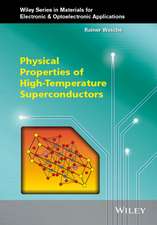Graphene for Transparent Conductors: Synthesis, Properties and Applications
Autor Qingbin Zheng, Jang-Kyo Kimen Limba Engleză Paperback – 15 oct 2016
Transparent conductors are used in a wide variety of photoelectronic and photovoltaic devices, such as liquid crystal displays (LCDs), solar cells, optical communication devices, and solid-state lighting. Thin films made from indium tin oxide (ITO) have thus far been the dominant source of transparent conductors, and now account for 50% of indium consumption. However, the price of Indium has increased 1000% in the last 10 years. Graphene, a two-dimensional monolayer of sp2-bonded carbon atoms, has attracted significant interest because of its unique transport properties. Because of their high optical transmittance and electrical conductivity, thin film electrodes made from graphene nanosheets have been considered an ideal candidate to replace expensive ITO films.
Graphene for Transparent Conductors offers a systematic presentation of the principles, theories and technical practices behind the structure–property relationship of the thin films, which are the key to the successful development of high-performance transparent conductors. At the same time, the unique perspectives provided in the applications of graphene and GO as transparent conductors will serve as a general guide to the design and fabrication of thin film materials for specific applications.
| Toate formatele și edițiile | Preț | Express |
|---|---|---|
| Paperback (1) | 384.86 lei 6-8 săpt. | |
| Springer – 15 oct 2016 | 384.86 lei 6-8 săpt. | |
| Hardback (1) | 392.21 lei 6-8 săpt. | |
| Springer – iul 2015 | 392.21 lei 6-8 săpt. |
Preț: 384.86 lei
Nou
Puncte Express: 577
Preț estimativ în valută:
73.65€ • 79.97$ • 61.87£
73.65€ • 79.97$ • 61.87£
Carte tipărită la comandă
Livrare economică 23 aprilie-07 mai
Preluare comenzi: 021 569.72.76
Specificații
ISBN-13: 9781493946082
ISBN-10: 1493946080
Pagini: 236
Ilustrații: XVI, 220 p. 124 illus., 88 illus. in color.
Dimensiuni: 155 x 235 x 13 mm
Greutate: 0.34 kg
Ediția:Softcover reprint of the original 1st ed. 2015
Editura: Springer
Colecția Springer
Locul publicării:New York, NY, United States
ISBN-10: 1493946080
Pagini: 236
Ilustrații: XVI, 220 p. 124 illus., 88 illus. in color.
Dimensiuni: 155 x 235 x 13 mm
Greutate: 0.34 kg
Ediția:Softcover reprint of the original 1st ed. 2015
Editura: Springer
Colecția Springer
Locul publicării:New York, NY, United States
Cuprins
Introduction to Transparent Conducting Films.- Synthesis, Structure and Properties of Graphene and GO.- Fabrication of Graphene-based Transparent Conducting Thin Films.- Improvement of Electrical Conductivity and Transparency.- Applications of Graphene-based TCs.- Conclusions and Perspectives.
Recenzii
“I found it to be a valuable resource and easy to read. … It is an enjoyable read with rich and valuable references to original works. It can be used as a fantastic learning tool for anyone who wants to get an overview of where graphene research is heading in terms of finding real applications, or for anyone looking for an application that could create and serve a niche market.” (Sudip Mukhopadhyay, MRS Bulletin, Vol. 41, July, 2016)
Notă biografică
Dr Qingbin ZHENG obtained his BSc in Applied Physics and MSc in Material Physics and Chemistry from China University of Petroleum, in 2005, 2008 respectively. He received his PhD degree from Department of Mechanical Engineering, Hong Kong University of Science and Technology (HKUST) in 2011. His PhD study was centered mainly on the synthesis of monolayer graphene sheets and their application for transparent conductors. He has published 25 high quality papers in top journals, including ACS Nano, Adv Funct Mater, Carbon and J Mater Chem. on advanced nanomaterials including graphene and carbon nanotubes. He is currently a visiting scholar at HKUST working on a variety of nanomaterials applications, including synthesis of graphene oxide, graphene-based thin films, graphene/polymer composites, and graphene for energy storage application.
Prof. Jang-Kyo KIM obtained his PhD degree in composite materials from Mechanical Engineering, University of Sydney. He started his faculty careerat Australian National University (1992-1994); and joined the Hong Kong University of Science & Technology (HKUST) in 1994. Prof. Kim is currently a full Professor and Director of the Finetex-HKUST R&D Center at HKUST. Kim has been active in both fundamental and applied researches. His current research activities are centred on the development, synthesis, characterisation of structure-property relationships of advanced materials, including nanomaterials such as carbon nanotubes, graphene, graphite nanoplates, nanoclay; polymer-based nanocomposites; fibre-reinforced composites; thin films/coatings; transparent conducting thin films; nanostructured materials for Li-ion battery and supercapacitors; and adhesion and debonding in multi-phase materials. Kim has widely written in the area of fibre reinforced composites, nanocomposites and nanostructured materials, with over 400 publications including two co-authored research monographs on fibre composites (in 1998) and carbon nanotube nanocomposites (in 2011); and presented well over 50 plenary/keynote lectures in international conferences as well as more than 80 invited talks/seminars worldwide. Kim and his research team members have been honored with seven Best Paper Awards from various international conferences and regional competitions. He is the Editor of Composites Part A, and Editorial Board Member for eight leading international journals in the broad area of advanced materials and composites.
Prof. Jang-Kyo KIM obtained his PhD degree in composite materials from Mechanical Engineering, University of Sydney. He started his faculty careerat Australian National University (1992-1994); and joined the Hong Kong University of Science & Technology (HKUST) in 1994. Prof. Kim is currently a full Professor and Director of the Finetex-HKUST R&D Center at HKUST. Kim has been active in both fundamental and applied researches. His current research activities are centred on the development, synthesis, characterisation of structure-property relationships of advanced materials, including nanomaterials such as carbon nanotubes, graphene, graphite nanoplates, nanoclay; polymer-based nanocomposites; fibre-reinforced composites; thin films/coatings; transparent conducting thin films; nanostructured materials for Li-ion battery and supercapacitors; and adhesion and debonding in multi-phase materials. Kim has widely written in the area of fibre reinforced composites, nanocomposites and nanostructured materials, with over 400 publications including two co-authored research monographs on fibre composites (in 1998) and carbon nanotube nanocomposites (in 2011); and presented well over 50 plenary/keynote lectures in international conferences as well as more than 80 invited talks/seminars worldwide. Kim and his research team members have been honored with seven Best Paper Awards from various international conferences and regional competitions. He is the Editor of Composites Part A, and Editorial Board Member for eight leading international journals in the broad area of advanced materials and composites.
Textul de pe ultima copertă
This book provides a systematic presentation of the principles and practices behind the synthesis and functionalization of graphene and graphene oxide (GO), as well as the fabrication techniques for transparent conductors from these materials.
Transparent conductors are used in a wide variety of photoelectronic and photovoltaic devices, such as liquid crystal displays (LCDs), solar cells, optical communication devices, and solid-state lighting. Thin films made from indium tin oxide (ITO) have thus far been the dominant source of transparent conductors, and now account for 50% of indium consumption. However, the price of indium has increased 1000% in the last 10 years. Graphene, a two-dimensional monolayer of sp2-bonded carbon atoms, has attracted significant interest because of its unique transport properties. Because of their high optical transmittance and electrical conductivity, thin film electrodes made from graphene nanosheets have been considered an ideal candidate to replace expensive ITO films.
Graphene for Transparent Conductors offers a systematic presentation of the principles, theories and technical practices behind the structure–property relationship of the thin films, which are the key to the successful development of high-performance transparent conductors. At the same time, the unique perspectives provided in the applications of graphene and GO as transparent conductors will serve as a general guide to the design and fabrication of thin film materials for specific applications.
Transparent conductors are used in a wide variety of photoelectronic and photovoltaic devices, such as liquid crystal displays (LCDs), solar cells, optical communication devices, and solid-state lighting. Thin films made from indium tin oxide (ITO) have thus far been the dominant source of transparent conductors, and now account for 50% of indium consumption. However, the price of indium has increased 1000% in the last 10 years. Graphene, a two-dimensional monolayer of sp2-bonded carbon atoms, has attracted significant interest because of its unique transport properties. Because of their high optical transmittance and electrical conductivity, thin film electrodes made from graphene nanosheets have been considered an ideal candidate to replace expensive ITO films.
Graphene for Transparent Conductors offers a systematic presentation of the principles, theories and technical practices behind the structure–property relationship of the thin films, which are the key to the successful development of high-performance transparent conductors. At the same time, the unique perspectives provided in the applications of graphene and GO as transparent conductors will serve as a general guide to the design and fabrication of thin film materials for specific applications.
Caracteristici
Provides a comprehensive overview of the synthesis of graphene and GO, as well as their structures and properties Describes traditional and novel methods for the preparation of transparent conductors from graphene and GO Offers perspectives on various techniques devised to improve electrical conductivity and transparency of graphene thin films Introduces the novel L-B assembly technique where graphene sheets are deposited layer-by-layer on a substrate Explains optimized fabrication processes for structural control and functionalization Includes supplementary material: sn.pub/extras







